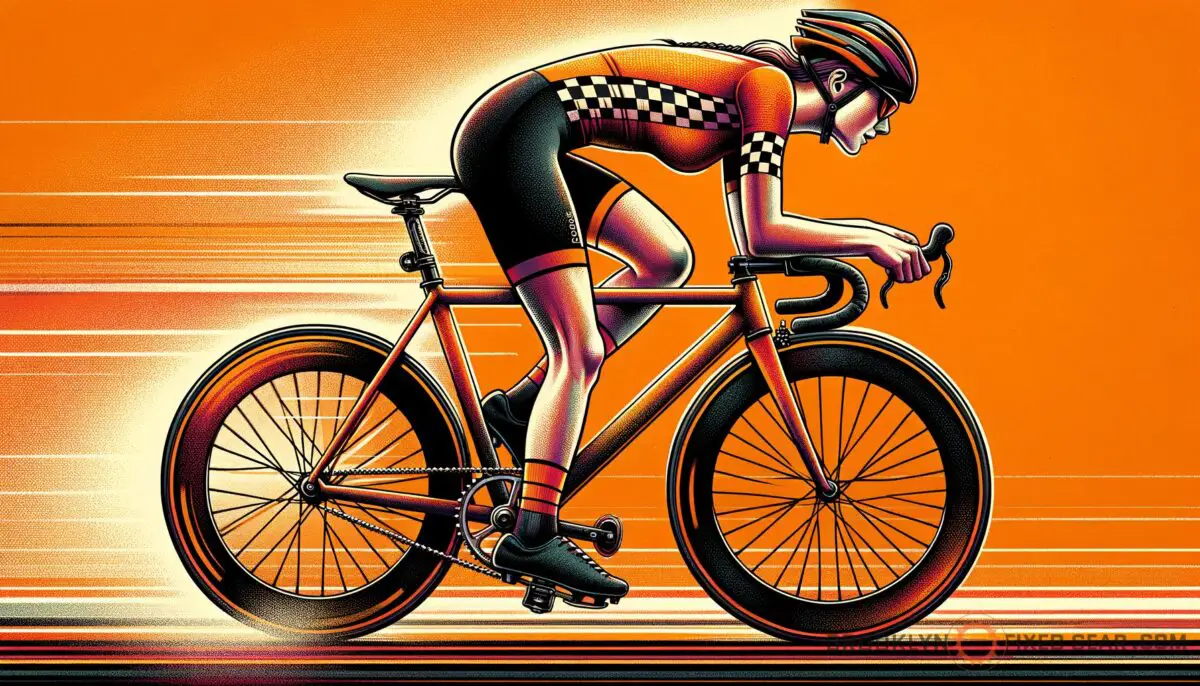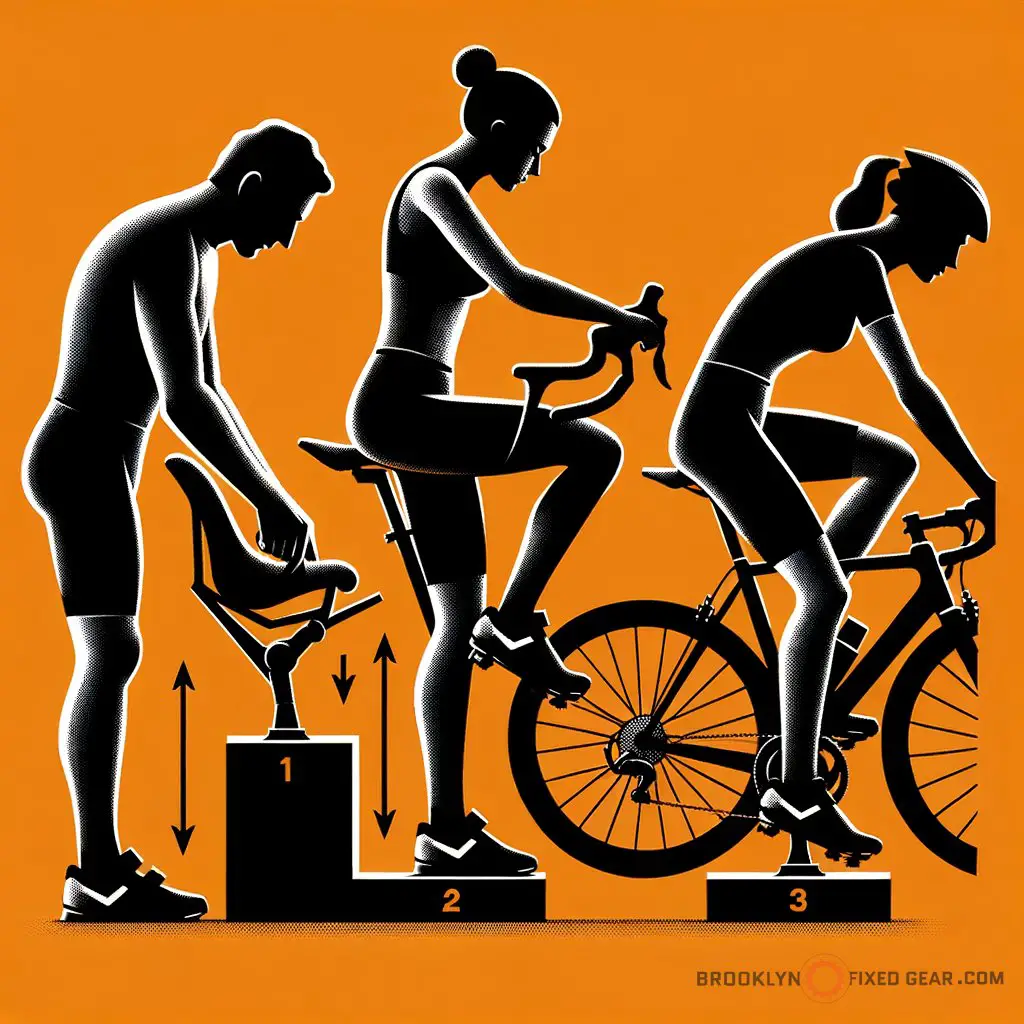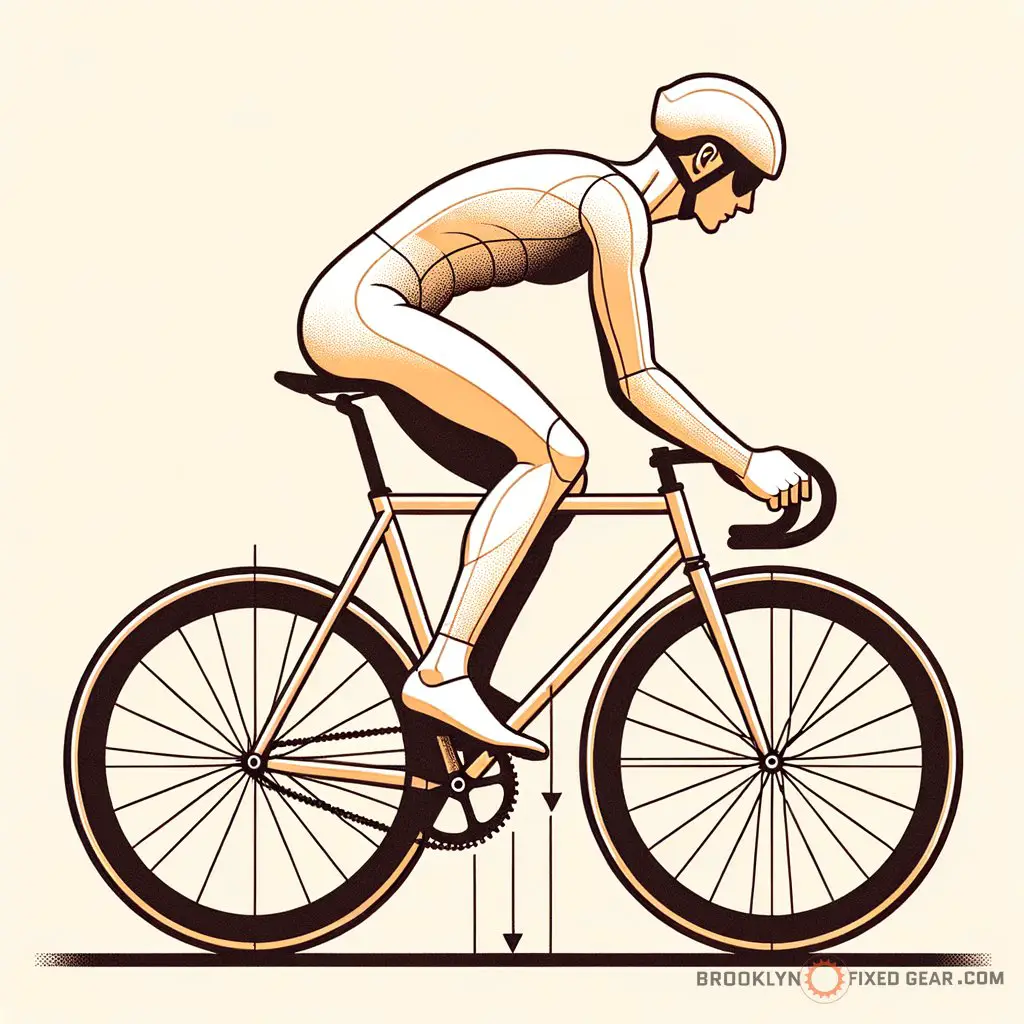Have you ever wondered why some riders make it look effortless while others are huffing and puffing? It could all come down to ergonomics, the science behind comfort and efficiency on two wheels. Discover what you need to know about ergonomic cycling, with a spin through the essentials of comfort on a fixie.
Key takeaways
- Adjust your saddle, handlebars, and pedals to minimize discomfort and maximize efficiency.
- Optimal cycling posture and ergonomic gear enhance endurance and pleasure.
- Making small on-the-go adjustments can prevent injuries and improve performance.
What is ergonomics in cycling?
Ergonomics in cycling is the study of how cyclists interact with their bikes, aiming to minimize discomfort and maximize efficiency. Think of it as fine-tuning your ride to fit like a glove. Here’s what that entails:

- Adjusting your saddle: The height and angle of your saddle can make or break your cycling comfort. When it’s set just right, you’ll pedal with ease and avoid unnecessary strain on your knees and back.
- Handlebar height and reach: Ever experience tingling fingers or sore shoulders after a ride? That’s a sign your handlebar setup isn’t ergonomic. Positioning your bars for an optimal reach and grip will keep those issues at bay. Check out some of the best fixie bike handlebars for comfort and control.
- Foot placement: The way your feet sit on the pedals affects your leg alignment and pedaling power. Ensuring proper cleat placement and pedal type can lead to a smoother ride and prevent injuries.
Remember, a well-adjusted bike minimizes the risk of chronic injuries and boosts your overall riding pleasure.
Ergonomics isn’t just about the bike; it’s also about the rider. Dress for success with cycling gear that complements the body’s movements and reduces drag. Learn the ropes of layering and selecting the right materials that breathe with you on every ride.
And don’t overlook your posture. Keeping your body aligned properly while riding is crucial. A straight back, relaxed shoulders, and bent elbows can help you ride longer and stronger.
So, ergonomics is that secret sauce that transforms a good ride into a great one. And to keep your ride top-notch, always carry a bike multi-tool for quick adjustments.
From what I’ve gleaned, ergonomics might seem like a bunch of mumbo jumbo, but it seriously changes the game. It’s like getting the right seat at a concert—you don’t want to crunch your neck looking at the stage, right? I heard about a buddy who tweaked his handlebars just slightly, and bam, his chronic wrist pain disappeared.
Kind of like that scene in “Breaking Away” where the main dude obsesses over Italian racers, down to the tiniest detail, including how he sits on that saddle. It goes to show, the smallest changes can lead to the most comfortable rides. Plus, dialing in your bike’s ergonomics makes you look as cool as a cucumber, even in the homestretch of a heated alleycat race.
Trust me, when you get it right, you’ll feel like that bike is an extension of you, as seamless as a classic Brooklyn track-bike carving through city streets.
State Bicycle Co. Black Label 6061

State Bicycle Co. Black Label 6061
Understanding ergonomics in cycling
Ergonomics is all about creating a comfortable, efficient, and injury-free cycling experience. By adjusting the contact points between you and your bike—like the saddle, handlebars, and pedals—you can achieve a ride that feels like it was crafted just for you.
The role of the saddle in cycling ergonomics
Your saddle is your primary contact point; getting this right is crucial. The right saddle height helps maintain an efficient pedal stroke, prevents knee pain, and makes long rides more enjoyable. For more in-depth details on choosing the perfect saddle, take a look at how to choose a bike saddle.

Handlebars and your ride
Handlebar height and reach are next in line for an ergonomic setup. They should allow for a natural arm position and a comfortable grip, reducing the pressure on your hands and wrists. Proper handlebar setup can prevent numbness and fatigue—you can find some top-notch options in best fixie bike handlebars.
Pedals and cleats positioning
Don’t overlook your pedals and cleats—they impact your efficiency and comfort. Positioning them correctly aligns your knees, hips, and ankles, which prevents injury and maximizes power transfer.
Fine-tuning your cycling posture
Optimal cycling posture minimizes discomfort and injuries, ensuring you can pedal longer with less fatigue. Think of your posture as the foundation of your ergonomic setup.
Aligning your body on the bike
A straight back, relaxed shoulders, and slightly bent elbows are marks of good cycling posture. This alignment helps distribute weight evenly and maintains proper balance on your bike.
The importance of ergonomic cycling gear
Wearing the right clothes plays a part in your bike’s ergonomics. Materials that stretch well and wick moisture away from your body can also enhance your comfort and performance.
More ergonomic considerations
There’s more to ergonomics than the setup of your bike. Your riding technique and the adjustments you make while riding also play a part.
Technique and efficiency
Using the correct pedaling technique and body positioning can improve your overall cycling ergonomics.
Regular adjustments on the go
Sometimes, slight tweaks during your ride can make a big difference. Having tools like a bike multi-tool handy can help you adjust on the go.
Correcting common ergonomic mistakes
Avoiding common bike setup mistakes is essential for a good ergonomic experience.
Pitfalls in bike assembly
Identify and fix errors in your bike’s assembly to prevent discomfort and injuries. See common mistakes at common mistakes made when building a fixie.
The impact of bike maintenance on ergonomics
Regular maintenance ensures your bike remains in an ergonomic setup, helping you avoid unnecessary strain and extend your bike’s life.
Before we take a deeper dive into the nitty-gritty of ergonomic cycling, here’s a data table that highlights key ergonomic adjustments and their impact on cycling comfort and efficiency.
| Ergonomic Adjustment | Purpose | Impact on Cycling |
|---|---|---|
| Saddle Height | Ensures efficient pedaling and prevents knee strain | Reduces fatigue, increases comfort |
| Handlebar Reach | Prevents shoulder and neck pain | Improves control and reduces pain |
| Cleat Position | Aligns knees and hips for optimal power transfer | Prevents joint injuries |
| Cycling Posture | Distributes weight evenly | Enhances balance and endurance |
| Cycling Gear | Supports body movement, manages moisture | Increases comfort, reduces chafing |
Ergonomics in cycling is the study of how cyclists interact with their bikes, aiming to minimize discomfort and maximize efficiency. It’s like fine-tuning your ride to fit like a glove, making sure every part of your bike is adjusted to your body.
When it comes to maximizing your bike’s ergonomics, there are certain do’s and don’ts to keep in mind. These tips will help you make informed decisions on how to optimize your ride for both comfort and performance. Here’s a table summarizing some key ergonomic practices:
| Do’s | Don’ts |
|---|---|
| Adjust your saddle to hip height | Ignore knee or back pain during rides |
| Align handlebars with your torso | Overreach or hunch over the handlebars |
| Set the cleats for a natural foot position | Position cleats without considering knee alignment |
| Maintain a relaxed posture while riding | Tense up your body during long rides |
| Wear cycling-specific, ergonomic gear | Wear loose-fitting or non-wicking clothing |

More cycling ergonomics tips
Ergonomics is a game-changer for any cyclist. It can turn an average ride into a stellar one and help in preventing long-term discomfort. Here’s a rundown of more steps you can take to boost your riding ergonomics:
- Use grip tape on your handlebars for better control and reduced vibration.
- Consider drop bars for more hand position options, which can alleviate fatigue.
- Install a bike saddle designed for your riding style; there are specific saddles for road, track, and fixed gear riding.
- Tune your bike’s drivetrain regularly for smoother pedaling and improved control.
- Incorporate regular stretching and strengthening exercises into your routine to support an ergonomic cycling posture.
- Take breaks during long rides to reset your posture and give your muscles a rest.
- Invest in quality cycling shorts with a padded chamois to reduce saddle discomfort.
- Attach a bike multi-tool to your frame or carry it in a saddlebag for on-the-go adjustments.
- Stay hydrated and nourished, as fatigue can lead to poor posture and ergonomics.
If you are a visual learner, check out this video titled ‘How To ACTUALLY Get Comfortable On Your Bicycle’
Frequently asked questions (FAQ)
What ergonomic factors should I consider for long-distance rides?
For extended journeys, your saddle comfort takes precedence, as prolonged periods of sitting can lead to numbness and discomfort. It’s also essential to have handlebars that allow for multiple positions, which helps prevent fatigue. Finally, attire that’s suited for long-distance—such as padded shorts and moisture-wicking jerseys—will keep you comfortable mile after mile.
How usually should I review and adjust my bike’s ergonomics?
You should assess your bike’s ergonomics regularly, as your body adapts and changes over time. Start by checking your setup every few months or after any prolonged break from cycling. Pay close attention to any discomfort or strain as these can be signals it’s time to review and tweak your ergonomics.
Can ergonomic adjustments improve my speed and endurance?
Absolutely! Ergonomic adjustments can lead to a more efficient transfer of power from your body to the bike, reducing wasted energy. A well-tuned ergonomic setup aligns your body for optimal performance, thus enhancing both your speed and endurance over time.
Final thoughts
Adjusting your bike for the perfect ergonomic fit is essential for a phenomenal riding experience. It not only bolsters comfort and efficiency but also shields you from injuries and chronic pain. Take the time to dial in your saddle, handlebars, and pedals—it’s a small investment for the gains you’ll get in comfort and performance.
What have been your experiences with cycling ergonomics? Did I cover everything you wanted to know? Let me know in the comments section below; I read and reply to every comment. If you found this article helpful, share it with a friend, and check out my full blog for more tips and tricks on cycling ergonomics. Thanks for reading and happy pedaling!















